Car Warning Lights
Precision Tune Auto Care wants you to be safe on the road. To help consumers understand different car warning lights that can illuminate on their dash, Joel Burrows, VP of Training/Research & Development (a.k.a. Precision Tune’s “Car Doctor”) offers advice about the most common car warning lights and what actions should be taken when they become illuminated.
Precision Tune Auto Care wants you to be safe on the road. To help consumers understand different car warning lights that can illuminate on their dash, Joel Burrows, VP of Training/Research & Development (a.k.a. Precision Tune’s “Car Doctor”) offers advice about the most common car warning lights and what actions should be taken when they become illuminated.
|
ABS Warning Light
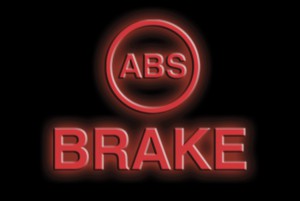
|
Anti-lock Braking works with your braking system to prevent wheels from locking, as well as traction control, brake assist and electronic stability control.When the ignition is turned on, this light should illuminate briefly to let you know the system is running properly. If it illuminates while driving, this indicates that there is an issue. Normal braking is still operational (without ABS).
Your vehicle is safe to drive, but have it checked out by a certified professional as soon as possible.
|
|
ABS & Brake System Warning Lights


|
If both the ABS and the Brake System Warning lights come on together while driving, stop the vehicle as soon as it is safe to do so.Reduce your speed gradually and immediately move to a safe location. Use the brakes carefully. Do not step on the brake pedal abruptly.
Seek professional assistance.
|
|
Battery Charge Warning Light
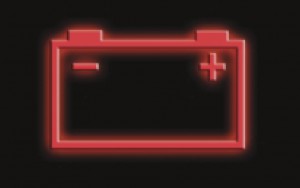
|
This light should illuminate when the ignition is turned on and should turn off as soon as the engine starts.If it does not illuminate at all, or if it illuminates while driving, your battery is not being charged because there is a fault with your charging system. This may be due to one of the following:
- Slack battery or starter terminals
- A broken or loose alternator drive belt
- An alternator failure
If the drive belt is broken, it must be replaced before you restart the engine. The coolant system may rely on this belt and its failure could cause the engine to overheat, in turn causing engine damage. Immediately move the vehicle to a safe location and turn off the engine.
Do not restart the vehicle and seek professional assistance.
|
|
Brake System Warning Light

|
This light will remain illuminated when the parking brake is in use. Illumination after releasing the parking brake may indicate low brake fluid level.Refer to your owner’s manual regarding brake fluid level. As the brakes wear, the fluid level will slowly drop. Be sure to have your brake fluid level checked each time you have your vehicle serviced to ensure there is not an abnormal loss of fluid, which requires more immediate attention.
If the brake fluid is too low and brake pedal travel is noticeably longer than usual, one of the two hydraulic brake circuits may have failed. Do not continue driving and seek professional assistance.
If the light remains illuminated, even though the brake fluid level is correct, this may indicate a sensor fault. Take your vehicle to a certified professional as soon as possible.
|
|
Check Engine Warning Light
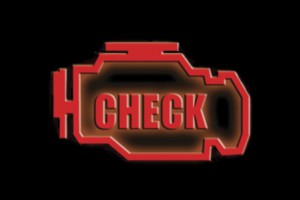
|
This is the most common warning light, and the most confusing as it can mean a number of different issues going on with your vehicle. This light illuminates when the ignition is turned on. It should turn off as soon as the engine starts.If it illuminates when the engine is running, it indicates a malfunction with the engine management system. Have this checked as soon as possible.
If it flashes when driving, reduce the vehicle speed immediately until the light illuminates constantly. If it continues to flash, avoid heavy acceleration and high engine speed, stop the vehicle and have it checked immediately.
Never ignore a continuing flashing check engine light! (In some vehicles, the light turns red.) If it is safe to do so, try stopping the vehicle, turning off the engine, waiting several minutes, then restarting the engine to reset the engine management system.
With the light illuminated, the vehicle is still safe to drive as long as no other faults are apparent with the engine. Have the vehicle checked by a certified professional as soon as possible to avoid any damage to the catalytic converter.
|
|
Low Coolant Level Warning Light
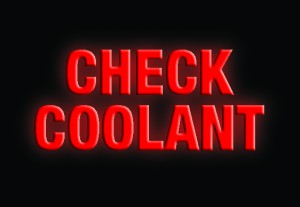
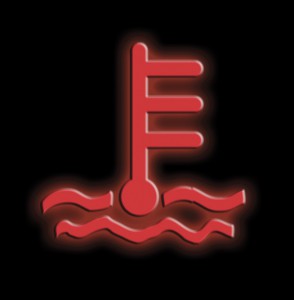
|
There are different methods on each vehicle that attempt to warn drivers of a cooling system issue. In newer vehicles, this may appear as a message to “check coolant” or “low coolant”.Low coolant does not necessarily translate to a potential overheating issue; however, this should be checked as soon as possible by a certified professional for any leaks or signs of potential drivability issues.
Note: Always check coolant level when the vehicle is cold.
A warning regarding your cooling system operation can also appear as a temperature warning light or a temperature gauge that moves into the red zone (which indicates the engine is running hot and requires immediate attention to avoid engine damage). Stop driving as soon as it is safe to do so and seek professional assistance. Continuing to drive with an overheated engine can cause serious engine damage.
Note: Do not attempt to open the radiator cap when the engine is overheating.
An overheating engine may be a result of a coolant leak. Have the cooling system inspected for leaks. Common leak points include radiator and heater hoses, the water pump and the radiator. Internal leaks (such as a crack in the head or engine) can’t be seen and can only be diagnosed by pressure testing the cooling system.
|
|
Engine Oil Pressure Warning Light
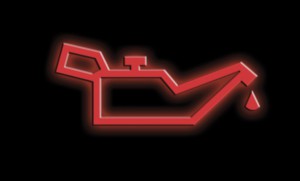
|
This light should illuminate when the ignition is turned on and should turn off as soon as the engine starts.If the light stays on after starting or illuminates while driving, stop immediately, turn off the engine and check the engine oil level. Add oil immediately if the level is low.
If the warning light illuminates, even though the oil level is correct, do not start the engine and seek professional assistance.
|
Other Types of Warning Lights:
Tire Pressure Monitoring System
This is an electronic system to monitor the air pressure inside a pneumatic tire; sometimes referred to as remote tire pressure monitoring systems (RTPMS) or simply as “run flat indicators”.
|
SRS (Airbag)
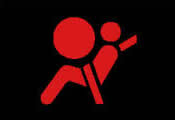 |
A warning light that looks like this or says SRS should NEVER come on unless there is a fault in your vehicle’s air bag system (also known as a supplemental restraint system or SRS). You can drive the vehicle but the air bag(s) will NOT deploy should you be involved in an accident. Have the problem diagnosed and repaired at your earliest convenience.
Always refer to your vehicle owner’s manual, as it should contain a detailed explanation of all warning lights specific to your vehicle’s make and model.
|
If any of these lights are illuminated the experts at your local Precision Tune Auto Care center can diagnose and fix the issue, getting you back on the road quickly and safely.